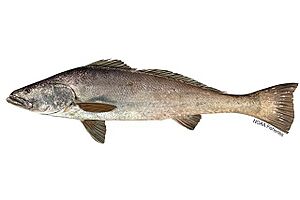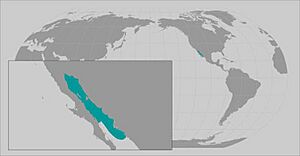Totoaba facts for kids
Quick facts for kids Totoaba |
|
|---|---|
 |
|
| Conservation status | |
| Scientific classification | |
 |
|
| Synonyms | |
|
Cynoscion macdonaldi Gilbert, 1890 |
The totoaba (Totoaba macdonaldi) is a very large marine fish. It belongs to the drum family and lives only in the Gulf of California in Mexico. It is the only species in its group, called Totoaba.
Long ago, there were many totoabas, and people fished for them a lot. But now, they are rare. The Convention on International Trade in Endangered Species of Wild Fauna and Flora lists them as highly endangered. The International Union for Conservation of Nature also says they are vulnerable.
Contents
Life Cycle and Growth
The totoaba is one of the biggest fish in the drum family. It can grow up to 2 meters (about 6.5 feet) long and weigh as much as 100 kilograms (about 220 pounds)! This makes it similar in size to the Chinese bahaba and the meagre fish.
Totoabas eat other finned fish and crustaceans, like crabs and shrimp. They can live for up to 15 years. However, they usually don't start having babies until they are 6 to 7 years old.
Totoabas only lay their eggs once a year. This means their population grows very slowly. It can take 4.5 to 15 years for their numbers to double. They lay their eggs in the Colorado River Delta. This area is also a safe place for young totoabas to grow up.
There are two main groups of totoabas. The young fish live in the Colorado River Delta. The adult fish, who are ready to have babies, spend most of the year in deeper water in the middle of the Gulf of California. These adults travel to the Colorado Delta in April and May to lay their eggs.
When they are about one year old, totoabas grow best in slightly salty water. This kind of water, called brackish water, used to be common in the delta. But things have changed.
Threats to Totoaba
The totoaba faces several big dangers that make it hard for them to survive.
Water Changes
A major problem for totoabas is that less fresh water reaches the Colorado River Delta. Big dams like the Hoover and Glen Canyon dams in the United States stop most of the river's water. Now, only about 4% of the water that used to flow into the delta actually gets there.
This change has made the delta's environment very different. The water in the upper Sea of Cortez is now much saltier. Young totoabas need water that is not too salty to grow well. This lack of fresh water is a main reason why the totoaba population has gone down.
Illegal Fishing
Another big threat to the totoaba is poaching, which is illegal fishing. People illegally catch totoabas mainly for their swim bladder. This part of the fish is considered a special food in Chinese cooking. The meat is also used to make soups.
These swim bladders can be sold for a lot of money. Some people in China wrongly believe they can help with health problems. The swim bladders are often smuggled to Hong Kong, where rules are not always strict. From there, they might go to mainland China.
This illegal trade used to focus on another fish, the Chinese bahaba. But when that fish became rare, people started targeting the totoaba instead. This illegal fishing also harms the vaquita. The vaquita is a very rare porpoise that lives only in the northern Gulf of California. It often gets caught by accident in the nets used for totoabas.
Conservation Efforts
Many groups are working to protect the totoaba.
It has been illegal to catch totoaba in Mexico since 1975. In 1976, it was added to an international list of endangered species. In 1979, the United States also put it on its endangered species list.
In 2015, the President of Mexico, Enrique Peña Nieto, announced a plan to save the vaquita and the totoaba. This plan included stopping fishing in certain areas and helping fishermen financially. This was important because totoabas were still being caught by accident, known as bycatch, in nets meant for other fish.
The illegal trade of totoaba swim bladders has caused a big drop in their numbers. Even though it was illegal, this trade often happened openly. Traders sometimes knew when checks were coming and could hide the swim bladders. More recently, both Mexican and Chinese authorities have started doing more checks and raids. This has led to many illegal swim bladders being taken and people being arrested.
Totoabas can also be raised in fish farming facilities. It's fairly easy to breed them in tanks, and they grow quickly. While some are raised for food, tens of thousands of totoabas born in captivity have been released into the wild. This is a big effort to help save the species.
Commercial Fishing History
People started fishing for totoaba for money in the 1920s. The amount of fish caught reached 2,000 tons in 1943. But by 1975, it had dropped to only 50 tons. That's when Mexico made it illegal to fish for totoaba.
Before commercial fishing began, people said there were many totoabas. However, there isn't clear proof of how many there were naturally. Recent studies show that the totoaba population has become stable, but at a low level. It might be a bit larger now than when fishing was banned in 1975.
Totoabas are still caught by accident when people fish for other fish or shrimp. They are also caught in illegal fishing specifically for totoabas. Some totoabas are illegally sent to the United States. They are sometimes wrongly called "white seabass" to hide what they are.
The government of Baja California has allowed private companies to raise totoabas on fish farms. While these farms now produce many totoabas, a lot of the first research on how to keep, breed, and raise them was done at the Autonomous University of Baja California.



